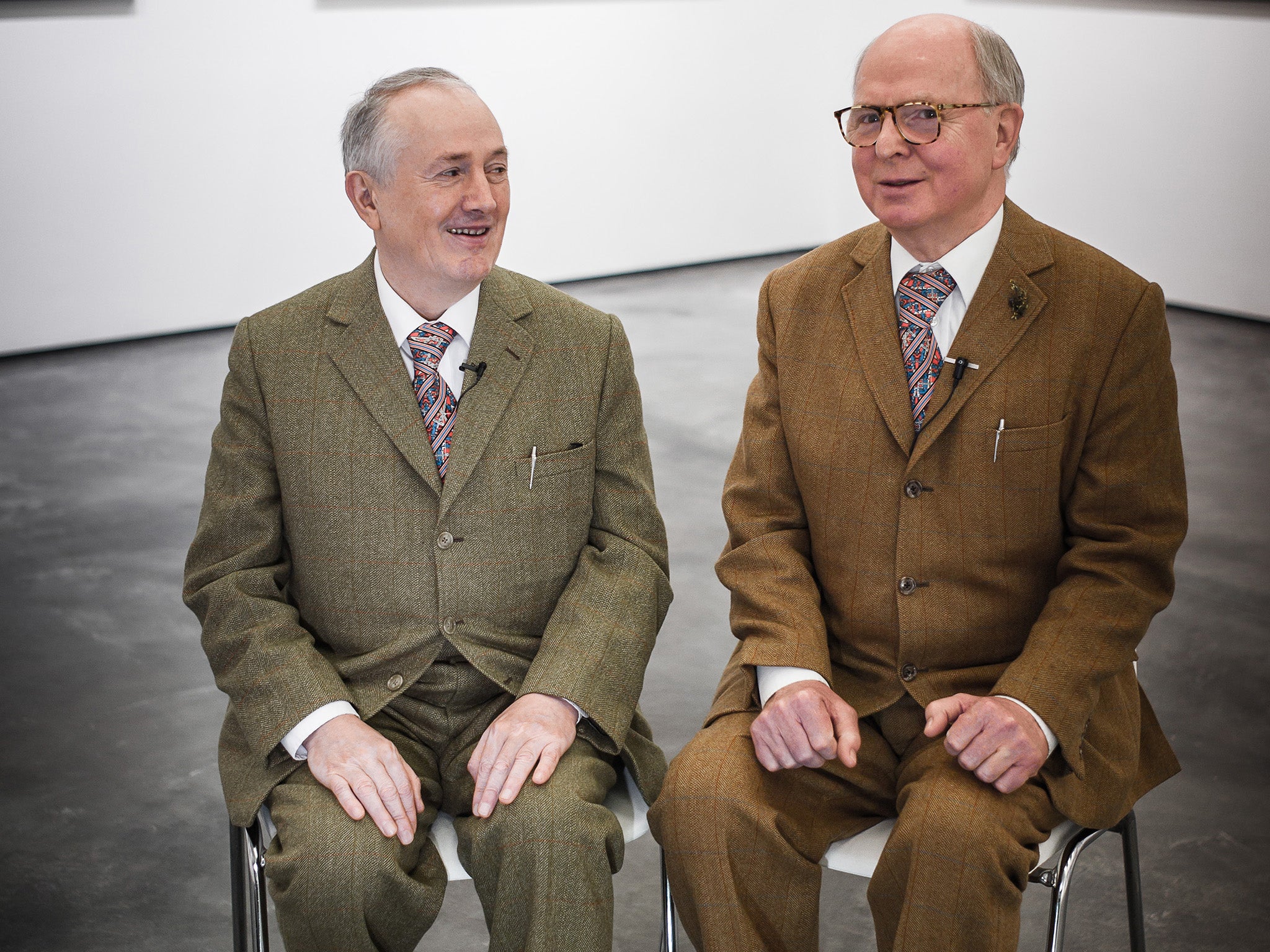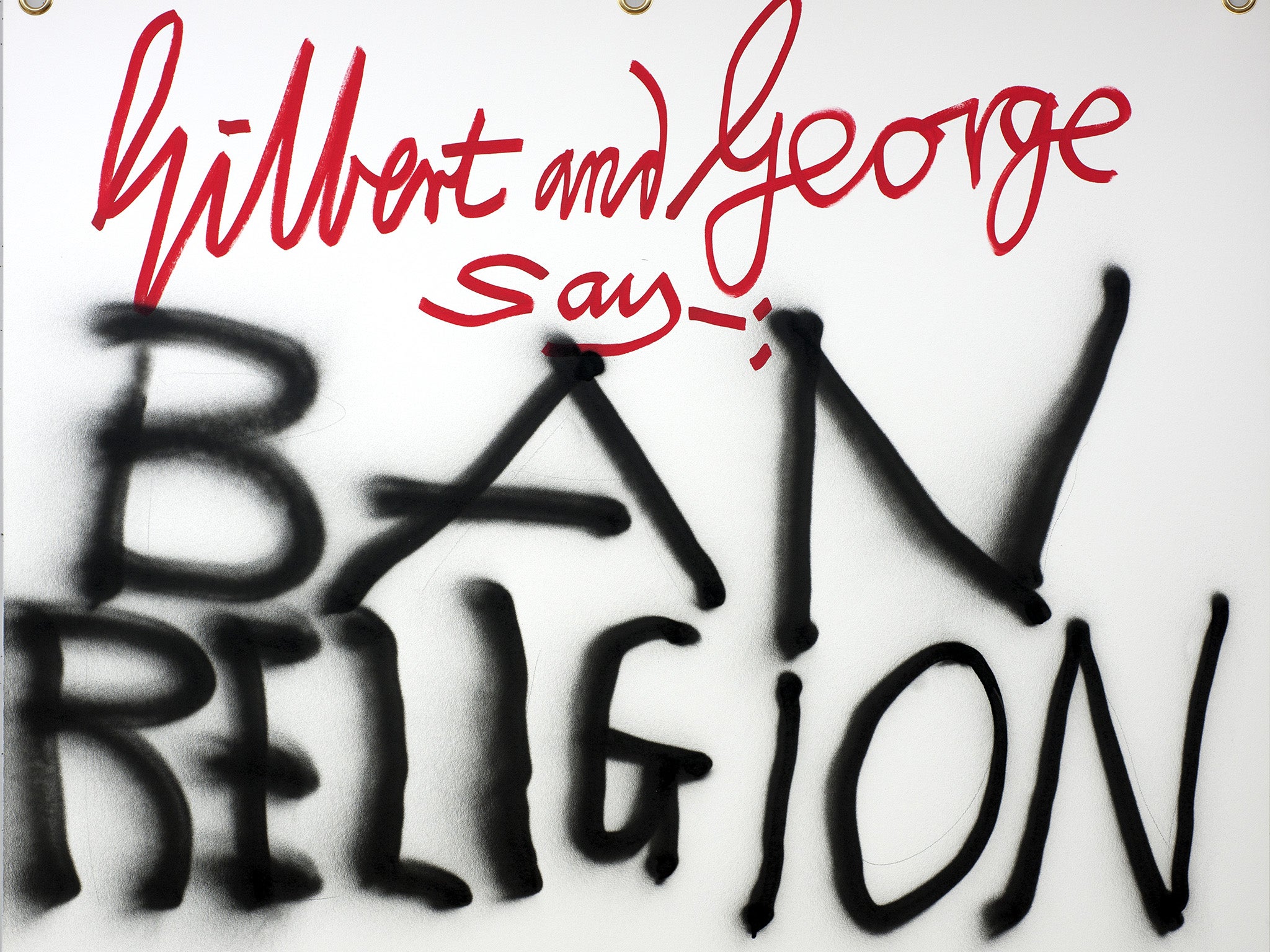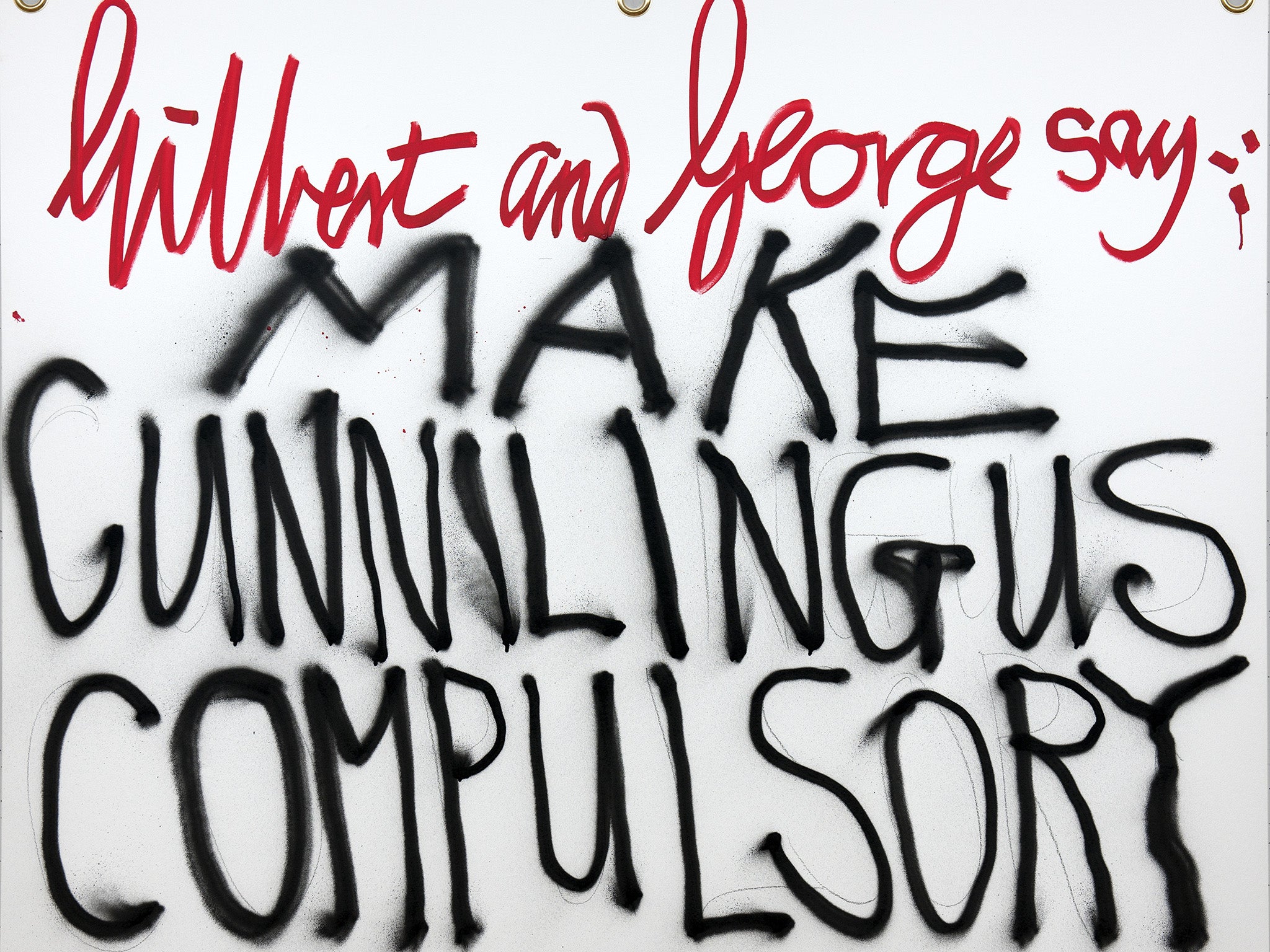Gilbert and George: Artists attempt to shock with a set of crude, expensive banners
Art has moved on

Jay Jopling’s sizable White Cube outpost in Bermondsey, south-east London, is home to Gilbert and George’s latest exhibition, The Banners. Entering the space I am confronted by a wall-mounted sign offering signed posters for £10 or a set of 10 for £50. Christmas presents, perhaps? With slogans that read “Fuck the Planet” or “Burn that Book”, probably not.
This is not the work of some disaffected youth in the depths of the East End, but of the performance duo Gilbert and George. Gilbert – Gilbert Proesch – was born in Italy in 1943 and grew up with Ladin as his first language. George – George Passmore – was born in 1942 and grew up in Portsmouth. They met at Saint Martin’s School of Art on 25 September 1967 and “it was love at first sight”, they say. They claim to have married in 2008. They are perhaps most famous for their sartorial smartness, matching suits and their walks around London, in particular around Fournier Street in East London, where they have done up a townhouse in exquisite taste to hold themselves and their work.
I give this biography as it is necessary to put all of their artwork into context. These are no young men but have been making work together for over 40 years, determined to shock far longer then their descendants, the group destined to be called Young British Artists forever.

These banners were first unveiled at the recent Serpentine Marathon 2015, the theme of which was “transformation”. The duo stood silently holding up the banners, facing the audience. A photograph in the catalogue (a steal for £5) captures the moment with the audience seemingly rapt, many recording the moment for posterity on their mobile phones. A short preface by Michael Bracewell, now the designated Gilbert and George interpreter, explains that the banners were first shown in the presence of Hans-Ulrich Obrist, another fierce supporter of the duo, and extols the beauty of the crudely signed banners with their rude and, one feels, deliberately offensive slogans.
In order to make it all historically correct, he draws an historical analogy with a Gilbert and George magazine sculpture from 1969, in which photographs of the duo are entitled George the C*** and Gilbert the S***.
Another of their early works saw them as “living sculptures”, sprayed bronze and singing “Underneath the Arches” in the Nigel Greenwood Gallery, the then small gallery that represented them. “Art for all” was the slogan that they invoked. Then there were the huge charcoal drawings, allegedly done on the boat from England to Germany, because they weren’t at all ready for their show with Kasper König, their first gallerist in Düsseldorf.
Fast-forward and the two men, now in their seventies, are inextricably woven into the art establishment. Their large signature, now almost a tag, instantly identifies these latest works as their own. Their show at Tate Modern in 2007 occupied the entire floor, the first to do so. They are enmeshed into the “star” curatorial web of Obrist and the international clientele of the White Cube gallery, and is the work better for it? Does the crudeness of the slogans on the banners, proclaiming some of their own concerns – “fuck him” – indicate their boredom with making yet another show? Sadly, yes. It feels as though the show were dreamed up over breakfast in their local greasy spoon café, where they stoke up daily with a full English, to satisfy the needs of both the Serpentine and their gallery.

White Cube has chosen to show the duo alongside Tight Rope Walk, a painting show curated by the New York critic Barry Schwabsky, a long-term advocate of painting. Drawing on the galleries’ enormous resources, none of the works are borrowed from museums, but come from private collections, and all bar a few are for sale. The title is drawn from a quote by Francis Bacon: “This image is a kind of tightrope walk between what is called figurative painting and abstraction. It will get right out from abstraction, but will really have nothing to do with it.”
Bacon’s contribution to the show is an intense study in orange for a 1982 portrait of Isabel Rawsthorne. There is a stunning Matisse portrait, a scatter of Picassos, a Morandi, a few wonderful Phillip Gustons, some earthy Lucian Freuds, a Francis Picabia and a group of younger artists exploring the theme of the transition from abstraction.
There are discoveries to be made here. A work by Rafael Ferrer, an artist born in 1933 in Puerto Rico, whose work is now hanging in the Whitney Museum in New York. Intervention 2015 speaks of its place in a way that only painting can: ramped-up tropical colour infuses the canvas and a strange hooded figure imbues the work with menace.
The small-scale, labour-intensive works of Ellen Altfest, a White Cube artist, also manage to stand up to scrutiny, and to their proximity to Double Sarah B, 2011, the large, seemingly effortless work of Alex Katz, one of the stars of the show.
Women do well here, with socking colour in Dana Schutz’s compressed figures in Fight in an Elevator 2015. In the opposite colour corner is Gillian Carnegie’s almost monochromatic and courageously restrained canvas, Section 2011. Rosa Loy’s Buch 2015 depicts a woman lost in her book beneath a large book bound in blue – a wonderful antidote to Gilbert and George’s crude banners.
Leaving the sanctuary of the paintings behind I visit Gilbert and George’s 30 banners again. There are only 10 slogans, so each is an edition of three (but unique, we are told, as they are hand-sprayed), priced at £22,500 each. In the past, Gilbert and George have utilised headlines from the London Evening Standard in their work, as well as bodily fluids, faeces and cards pinned up by rent boys. Why does this work make me so angry? In a world transformed forever by the events in Paris, can we really stand by a banner saying simply “Ban Religion”?
Is this art of our times dealing with the issues of our times – or work to be hung on the walls of the rich to look prescient and cool? Over to you, viewer. At least if you come to Bermondsey, you can also look at the work of a true revolutionary – Pablo Picasso.
‘Gilbert and George: The Banners and Tight Rope Walk’, curated by Barry Schwabsky, continues at White Cube, Bermondsey, London SE1 until 24 January (whitecube.com)
Join our commenting forum
Join thought-provoking conversations, follow other Independent readers and see their replies
Comments